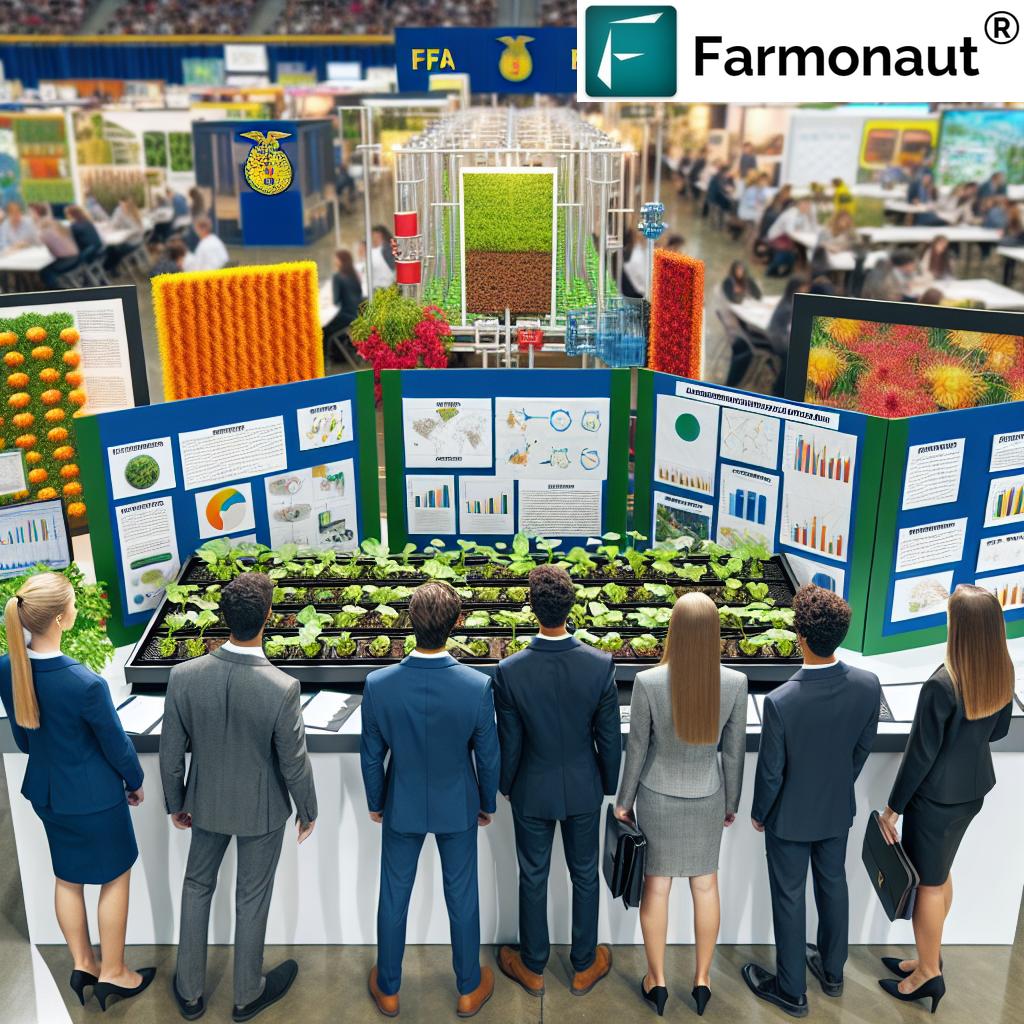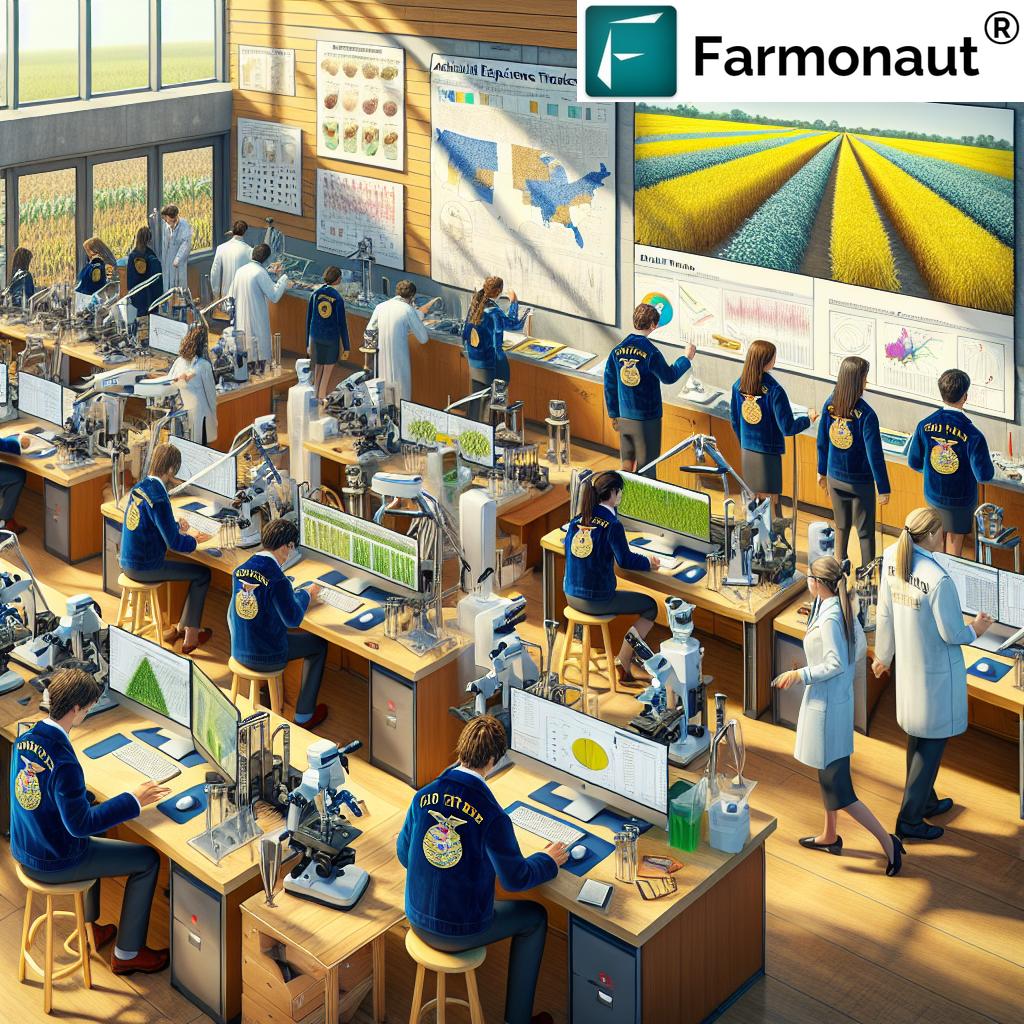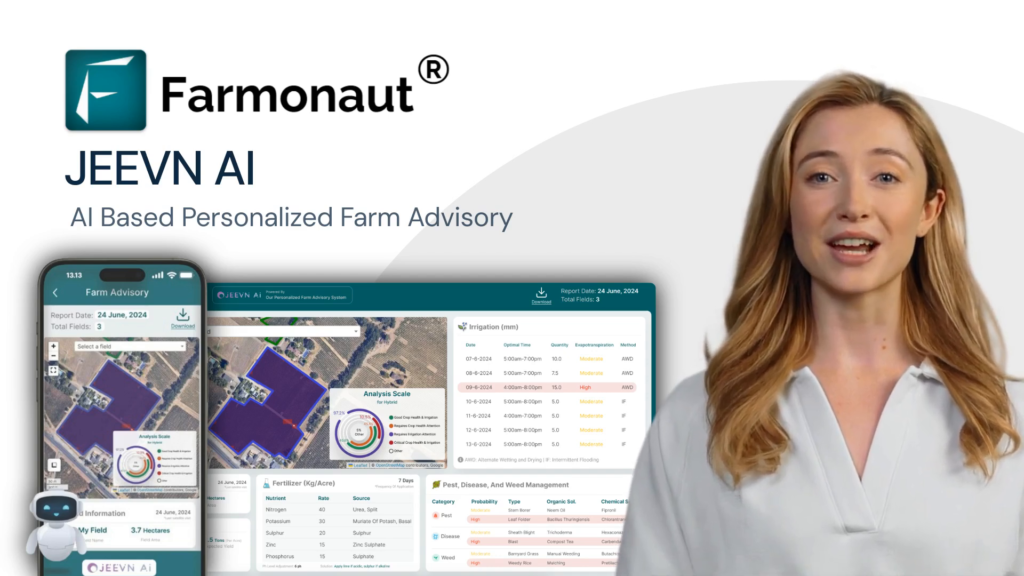Revolutionizing Texas Agriculture: How the FFA Agriscience Fair Cultivates Future Farming Leaders

“The FFA Agriscience Fair spans multiple levels, from state to national, covering 6 distinct categories including Animal Systems and Food Products Processing.”
In the heart of Texas, a revolution is taking place in the world of agriculture. The FFA Agriscience Fair is not just an event; it’s a catalyst for change, nurturing the next generation of farming leaders who will shape the future of our food systems. As we delve into this comprehensive exploration of the Agriscience Fair, we’ll uncover how this program is transforming agricultural education and paving the way for innovative farming practices.
The Essence of the FFA Agriscience Fair
The FFA Agriscience Fair stands as a cornerstone of agricultural science education, offering students a unique platform to conduct scientific research in agriculture and showcase their findings. This comprehensive program spans from state-level competitions to national conventions, fostering innovation in plant systems, environmental services, and farming technology.
At its core, the Agriscience Fair is designed to:
- Encourage students to apply scientific principles and emerging technologies to real-world agricultural problems
- Provide a competitive environment that fosters excellence in agriscience
- Reinforce classroom learning with practical, hands-on research experience
- Showcase the diverse career opportunities available in the agricultural sciences
As we at Farmonaut observe the progression of these young minds, we’re reminded of the importance of integrating advanced technology into agricultural practices. Our satellite-based farm management solutions complement the educational goals of the Agriscience Fair, supporting the next generation of agricultural leaders in their pursuit of cutting-edge scientific applications in farming.
The Structure of the Agriscience Fair
The FFA Agriscience Fair is meticulously structured to accommodate various levels of participation and areas of research. Let’s break down the key components:
Competition Categories
| Category | Description | Estimated Annual Participants |
|---|---|---|
| Animal Systems | Research related to animal nutrition, breeding, genetics, and management | 2,500 |
| Plant Systems | Studies on crop production, soil science, and plant genetics | 2,200 |
| Environmental Services | Projects focused on environmental impact, conservation, and sustainability | 1,800 |
| Food Products Processing | Research on food safety, product development, and processing technologies | 1,500 |
| Natural Resource Systems | Studies related to wildlife, forestry, and water resource management | 1,700 |
| Power, Structural, and Technical Systems | Projects involving agricultural machinery, alternative energy, and precision agriculture | 1,600 |
This diverse range of categories ensures that students with varying interests within agriculture can find their niche and contribute meaningfully to the field.
Participation Levels
The Agriscience Fair caters to different grade levels, allowing for fair competition among peers:
- Division 1: Individual members in grades 7-8
- Division 2: Team members in grades 7-8
- Division 3: Individual members in grades 9-10
- Division 4: Team members in grades 9-10
- Division 5: Individual members in grades 11-12
- Division 6: Team members in grades 11-12
This division structure ensures that students compete against others at similar educational levels, fostering fair competition and appropriate challenges for each age group.
The Journey from State to National
The path to success in the FFA Agriscience Fair is a journey that begins at the state level and culminates at the national convention. Here’s how the process unfolds:
- State-Level Competition: Students first compete within their state, presenting their research projects to local judges.
- State Winners: Top performers at the state level are eligible to advance to the national competition.
- National Pre-Qualification: State winners submit their projects for review by a national panel of judges.
- National Finalists: The top 12 projects in each category and division are invited to present at the National FFA Convention & Expo.
- National Convention: Finalists showcase their projects and undergo interviews with industry experts and scientists.
This multi-tiered approach ensures that only the most outstanding projects make it to the national stage, maintaining the high standards of the competition.

The Research Process: From Concept to Presentation
Participating in the Agriscience Fair is a comprehensive learning experience that mimics real-world scientific research processes. Students engage in a multi-step journey:
- Identifying a Research Question: Students must choose a relevant agricultural issue to investigate.
- Literature Review: Conducting thorough background research to understand existing knowledge on the topic.
- Hypothesis Formation: Developing a testable hypothesis based on their research question.
- Experimental Design: Creating a robust methodology to test their hypothesis.
- Data Collection and Analysis: Gathering data through experimentation and analyzing results using statistical methods.
- Conclusion Drawing: Interpreting results and drawing conclusions based on the data.
- Report Writing: Compiling findings into a comprehensive research paper following APA style guidelines.
- Presentation Preparation: Developing visual aids and practicing oral presentations for the fair.
This process not only teaches students about agricultural science but also instills valuable skills in critical thinking, problem-solving, and scientific communication.
“Participants in the Agriscience Fair submit their applications and research papers through the Agricultural Experience Tracker (AET) system, streamlining the process.”
The Role of Technology in Modern Agriscience Research
As the agricultural industry evolves, so does the technology used in agriscience research. Students participating in the FFA Agriscience Fair are encouraged to incorporate cutting-edge technologies into their projects. This is where companies like Farmonaut play a crucial role in supporting young researchers.
Farmonaut’s advanced agritech solutions provide valuable tools for students conducting research in areas such as:
- Crop health monitoring using satellite imagery
- AI-driven agricultural advisory systems
- Precision agriculture techniques
- Sustainable farming practices
By leveraging these technologies, students can enhance the quality and relevance of their research projects, preparing them for the future of agriculture.
The Impact of the Agriscience Fair on Agricultural Education
The FFA Agriscience Fair has a profound impact on agricultural education, extending far beyond the competition itself. Let’s explore some of the key ways this program is shaping the future of farming:
Fostering Scientific Literacy in Agriculture
By engaging in rigorous research projects, students develop a deep understanding of scientific principles and their application to agricultural challenges. This scientific literacy is crucial for addressing complex issues such as food security, climate change adaptation, and sustainable farming practices.
Encouraging Innovation and Creativity
The Agriscience Fair provides a platform for students to think creatively and develop innovative solutions to real-world agricultural problems. This spirit of innovation is essential for driving progress in the industry and ensuring its ability to meet future challenges.
Developing Future Agricultural Leaders
Through the process of conducting research, presenting findings, and competing at various levels, students develop crucial leadership skills. These include:
- Critical thinking and problem-solving abilities
- Effective communication and presentation skills
- Project management and time organization
- Collaboration and teamwork (for team projects)
These skills are invaluable not only in agricultural careers but in any professional path students may choose to pursue.
Bridging the Gap Between Education and Industry
The Agriscience Fair serves as a bridge between classroom learning and real-world agricultural practices. By working on projects that address current industry challenges, students gain practical experience that prepares them for future careers in agriculture.
Check out Farmonaut’s API Developer Docs
The Judging Process: Ensuring Quality and Fairness
The success of the FFA Agriscience Fair relies heavily on its rigorous and fair judging process. Let’s break down how projects are evaluated:
Judging Criteria
Projects are assessed based on several key factors:
- Scientific Thought (25%): The depth of scientific inquiry and adherence to scientific methods.
- Scientific Method (25%): The proper use of research techniques and experimental design.
- Presentation (25%): The clarity and effectiveness of both written and oral presentations.
- Knowledge Gained (25%): The student’s understanding of their project and its broader implications.
The Judging Process
- Pre-Qualification: Projects are first evaluated at the state level.
- National Screening: Qualified projects undergo a rigorous screening process by a panel of expert judges.
- Finalist Selection: The top 12 projects in each category and division are selected as national finalists.
- National Convention Judging: Finalists present their projects in person and undergo interviews with judges.
Ensuring Fairness and Quality
To maintain the integrity of the competition, the FFA implements several measures:
- Standardized rubrics are used across all levels of judging.
- Judges are trained to evaluate projects consistently and objectively.
- Multiple judges review each project to minimize bias.
- Strict ethical guidelines are enforced to prevent plagiarism or misconduct.
This comprehensive judging process ensures that the most deserving projects rise to the top, maintaining the high standards of the Agriscience Fair.
The Role of Teachers and Mentors
Behind every successful Agriscience Fair project is a dedicated team of educators and mentors. These individuals play a crucial role in guiding students through the research process and preparing them for competition.
Teacher Responsibilities
- Introducing students to the Agriscience Fair and its requirements
- Helping students identify research topics and formulate hypotheses
- Guiding students through the research process and experimental design
- Assisting with data analysis and interpretation
- Reviewing and providing feedback on research papers and presentations
- Ensuring adherence to ethical guidelines and safety protocols
The Importance of Industry Mentors
Many successful Agriscience Fair projects benefit from the involvement of industry professionals who serve as mentors. These individuals can:
- Provide real-world context for research topics
- Offer access to specialized equipment or facilities
- Share insights on current industry challenges and innovations
- Help students network and explore career opportunities
The collaboration between teachers, mentors, and students creates a rich learning environment that extends beyond the classroom, preparing students for future success in agriculture and related fields.
Download Farmonaut’s Android App

The Impact of Recent Rule Changes
The FFA Agriscience Fair, like any dynamic educational program, undergoes periodic updates to ensure it remains relevant and effective. Recent rule changes have been implemented to enhance the quality of research and streamline the competition process.
Key Rule Changes
- Submission Process: The implementation of the Agricultural Experience Tracker (AET) system for applications and paper submissions has digitized and streamlined the process.
- Research Paper Requirements: Updated guidelines for research paper formatting and content have been introduced to align with current academic standards.
- Judging Criteria: Refinements to the judging rubric have been made to better assess the depth and quality of scientific inquiry.
- Ethics and Safety: Enhanced protocols for ensuring ethical research practices and participant safety have been put in place.
Impact of Changes
These rule changes have had several positive effects on the competition:
- Improved quality of research projects
- More efficient administration of the competition at all levels
- Better preparation of students for higher education and industry standards
- Increased focus on ethical considerations in agricultural research
By staying current with industry trends and educational best practices, the Agriscience Fair continues to provide a cutting-edge platform for young researchers in agriculture.
Beyond the Fair: Career Opportunities and Continuing Education
Participation in the FFA Agriscience Fair opens doors to numerous opportunities for students, both in terms of career paths and continuing education.
Career Pathways
The skills and knowledge gained through the Agriscience Fair prepare students for diverse careers in agriculture and related fields, including:
- Agricultural Research Scientists
- Agronomists
- Food Scientists and Technologists
- Environmental Scientists
- Agricultural Engineers
- Precision Agriculture Specialists
- Biotechnologists
- Agricultural Policy Analysts
Continuing Education
Many Agriscience Fair participants go on to pursue higher education in agriculture-related fields. The experience gained through the fair can be beneficial for:
- College applications and scholarships
- Undergraduate research opportunities
- Internships with agricultural companies and research institutions
- Graduate school admissions
Scholarships and Awards
Success in the Agriscience Fair can lead to various recognitions and financial support for education:
- National FFA Organization scholarships
- Industry-sponsored awards and grants
- Recognition from state and national agricultural associations
- Opportunities for paid internships and research assistantships
These opportunities not only provide financial support but also valuable networking and professional development experiences for aspiring agricultural leaders.

The Role of Technology in Advancing Agriscience Research
As we’ve seen throughout this exploration of the FFA Agriscience Fair, technology plays a crucial role in advancing agricultural research and practices. Companies like Farmonaut are at the forefront of this technological revolution, providing tools and insights that complement the educational goals of programs like the Agriscience Fair.
Farmonaut’s Contribution to Agricultural Advancement
Farmonaut’s suite of advanced agritech solutions offers valuable resources for both students and professionals in agriculture:
- Satellite-Based Crop Monitoring: Provides real-time data on crop health, helping researchers and farmers make informed decisions.
- AI-Powered Advisory Systems: Offers personalized recommendations based on data analysis, enhancing crop management strategies.
- Blockchain-Based Traceability: Ensures transparency in agricultural supply chains, a crucial aspect of modern food production and distribution.
- Resource Management Tools: Helps optimize the use of water, fertilizers, and other inputs, promoting sustainable farming practices.
These technologies not only support current agricultural practices but also inspire new areas of research for students participating in events like the Agriscience Fair.
The Future of the FFA Agriscience Fair
As we look to the future, the FFA Agriscience Fair is poised to continue its role as a catalyst for innovation in agricultural education and research. Here are some trends and developments we can expect to see:
Integration of Emerging Technologies
- Increased use of AI and machine learning in research projects
- Incorporation of virtual and augmented reality for project presentations
- Greater emphasis on data analytics and big data in agricultural research
Focus on Sustainable and Regenerative Agriculture
- More projects addressing climate change and environmental sustainability
- Research on alternative farming methods and crop varieties
- Studies on reducing the carbon footprint of agricultural practices
Expansion of Global Partnerships
- Increased collaboration with international agricultural organizations
- Cross-cultural research projects addressing global food security issues
- Virtual exchange programs with students from other countries
Enhanced Career Preparation
- More direct connections between research projects and industry needs
- Expanded mentorship programs with agricultural professionals
- Integration of entrepreneurship and business skills into project development
As these developments unfold, the FFA Agriscience Fair will continue to play a vital role in shaping the future of agriculture, preparing students to tackle the complex challenges facing our food systems and natural resources.
Conclusion: Cultivating the Future of Agriculture
The FFA Agriscience Fair stands as a testament to the power of hands-on learning and scientific inquiry in agricultural education. By providing students with a platform to explore, innovate, and present their findings, this program is nurturing the next generation of agricultural leaders who will shape the future of farming in Texas and beyond.
As we’ve seen, the impact of the Agriscience Fair extends far beyond the competition itself. It instills valuable skills, fosters scientific literacy, and opens doors to diverse career opportunities in agriculture and related fields. The integration of cutting-edge technologies, such as those provided by companies like Farmonaut, further enhances the relevance and impact of student research projects.
Looking ahead, the FFA Agriscience Fair is well-positioned to adapt to the evolving needs of the agricultural industry. By embracing emerging technologies, addressing pressing global challenges, and maintaining its commitment to rigorous scientific inquiry, the program will continue to play a crucial role in revolutionizing Texas agriculture and inspiring future farming leaders.
As we celebrate the achievements of Agriscience Fair participants and look forward to the innovations they will bring to the field, we are reminded of the importance of supporting and investing in agricultural education. It is through programs like this that we can ensure a sustainable, productive, and innovative future for agriculture in Texas and around the world.

FAQs about the FFA Agriscience Fair
- Q: Who is eligible to participate in the FFA Agriscience Fair?
A: The FFA Agriscience Fair is open to FFA members in grades 7-12 who are actively engaged in agriscience research. - Q: How are projects judged in the Agriscience Fair?
A: Projects are judged based on scientific thought, method, presentation, and knowledge gained. Judging occurs at state and national levels, with top projects advancing to the National FFA Convention. - Q: What types of projects can students submit to the Agriscience Fair?
A: Students can submit projects in six categories: Animal Systems, Plant Systems, Environmental Services, Food Products Processing, Natural Resource Systems, and Power, Structural, and Technical Systems. - Q: How can technology like Farmonaut’s solutions be incorporated into Agriscience Fair projects?
A: Students can use Farmonaut’s satellite-based crop monitoring, AI advisory systems, and resource management tools to enhance their research projects, particularly in areas related to precision agriculture and sustainable farming practices. - Q: What are the benefits of participating in the FFA Agriscience Fair?
A: Benefits include hands-on research experience, development of critical thinking and presentation skills, opportunities for scholarships and awards, and preparation for careers in agriculture and related sciences.
















